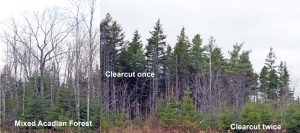
Conversion of mixed Acadian forest to industrial softwood forest is occurring on some, seemingly on a lot, of our Crown lands
He concludes “I would say developing Crown land management in Nova Scotia, when compared to many other countries, is worthy of international recognition for its progressive approach.”
———-
I agree, the developing approach looks very good on paper. I am guessing he used the word “developing” strategically, as it would be hard to disagree with the written intentions and rationale of NSDNR’s forest management policies (e.g. as presented in the Code of Forestry Practices). It’s the apparent lack of application of those policies now (I cited one example just yesterday), and the visible results (widespread clearcutting/conversion of mixed, multi-aged Acadian forest to short rotation, even-aged softwoods) that’s upsetting to many people.
Further when (as a scientist) I dig down a bit, it’s evident that some of the critical premises are not well founded scientifically, notably NSDNR’s estimate that “Frequent disturbance regimes are dominant on 43% of the landbase” (view NSDNR’s nature-based forestry).
On the other hand, one of the few components of NSDNR research that has been subjected to peer review (the Forest Nutrient Budget Model) underscores the fragile nature of our soil base and suggests that a high proportion of harvests on Class 1 Gibralter soils which cover much of our province are not sustainable (NSDNR has yet to highlight the paper); and well reviewed research, largely by NS Dept of Environment and academic researchers on the endangered boreal felt lichen is specifically dismissed by at the least the higher echelons of NSDNR.
In regard to “A successful species-at-risk protection program” I have to wonder about the writer’s criterion for success. The Auditor-general concluded that NSDNR is not fulfilling its mandate in this regard.
Sometimes the best of intentions are simply not enough.
